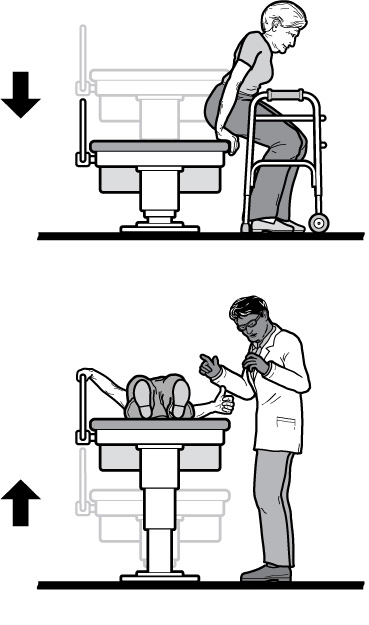Exam Tables and Chairs
Traditional fixed-height exam tables and chairs (also called treatment tables or procedure tables) are too high for many people with a mobility disability to use. Individuals with mobility disabilities often need to use an adjustable-height table which, when positioned at a low height, allows them to transfer from a wheelchair. A handle or support rail is often needed along one side of the table for stability during a transfer and during the examination.
Individuals transfer to and from adjustable-height exam tables and chairs differently. Some will be able to transfer on their own by standing up from a mobility device, pivoting, and sitting down on the exam table. Those using walkers may simply walk to the exam table and sit down, while others with limited mobility may walk more slowly and need a steadying arm or hand to help with balance and sitting down. Some people using wheelchairs may be able to independently transfer to the table or chair, while others will need assistance from a staff member. Transfers may also require use of equipment, such as a transfer board or patient lift.
An accessible exam table or chair should have at least have the following:
- ability to lower to the height of the wheelchair seat, 17‒19 inches from the floor; and
- elements to stabilize and support a person during transfer and while on the table, such as rails, straps, stabilization cushions, wedges, or rolled up towels.

An adjustable height exam table shown in lowered and raised positions
Once a patient has transferred, staff should ask if assistance is needed -- some patients may need staff to stay and help undress or stabilize them on the table. Never leave the patient unattended unless the patient says they do not need assistance.
Different types of exam tables are used for different purposes. Some exam tables fold into a chair-like position; others remain flat. Either type can be used by people with disabilities with the right accessible features and table accessories. Pillows, rolled up towels, or foam wedges may be needed to stabilize and position the patient on the table. Tilt, adjustability, and headrests, footrests, and armrests may make the examination more accessible for the patient and also easier for the doctor.

User Comments/Questions
Add Comment/Question